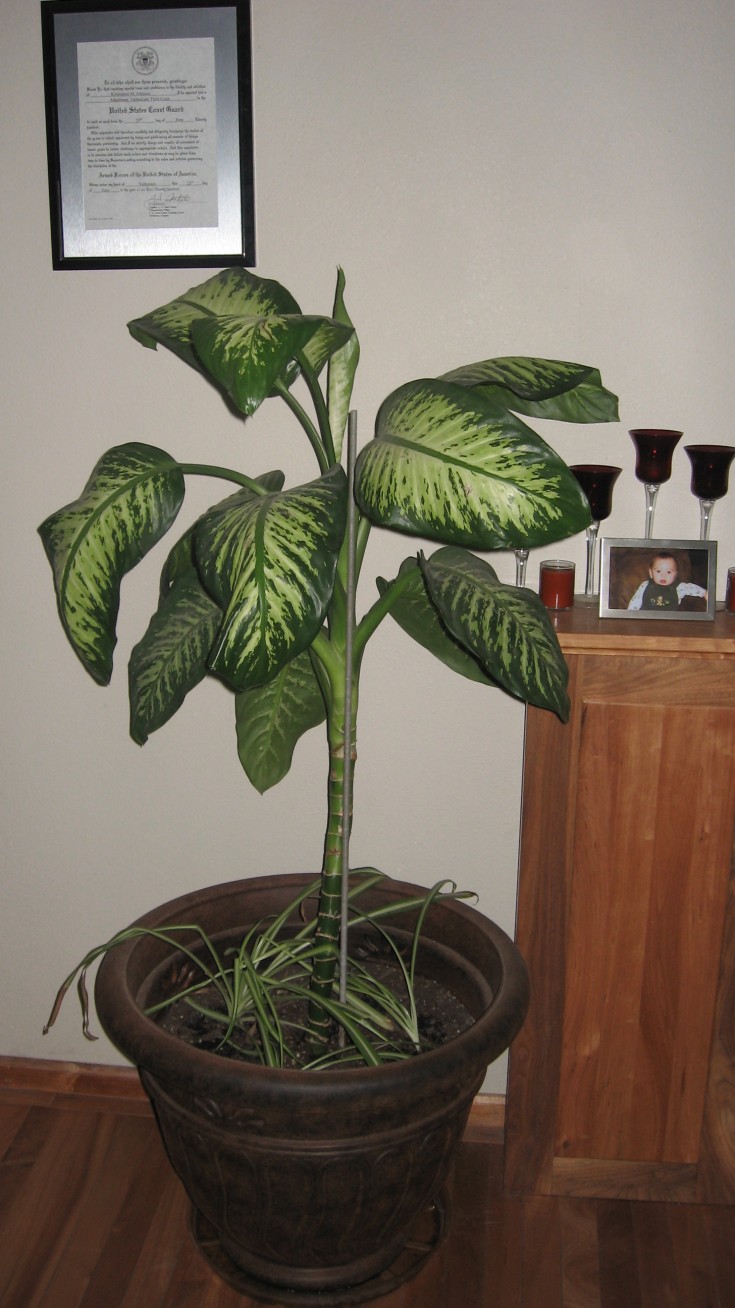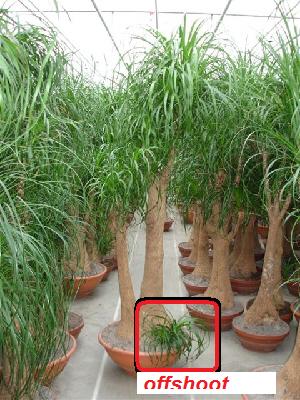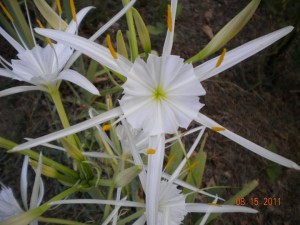I re-potted my red-margined dracaena and now it appears to be dying. The leaves from the bottom are brown and falling off and the entire plant is looking droopy. Is there anything I can do to revive it?
Why Does Over-Watering Kill Plants?
In the past, I have always started my cuttings in a glass of water, and once they got roots, tried to put them in dirt. This sometimes works, sometimes doesn’t.
I broke a big chunk off one of my plants when trying to get it to grow the way I wanted it to. So I broke off all the stems, stuck them in some dirt, and have kept the dirt saturated with water. When I say saturated, I mean nearly liquid, there is standing water on top of the soil.
I think, after a week or so, I will start backing off on the water, and I will have a plant.
What I really don’t understand is if plants can grow as cuttings in a glass of water, why does over watering kill plants? If it is impossible for water to kill a plant, and apparently it is, then there is some other mechanism at work when you over water. – Pete
Help! What Is This Plant & How Do I Propogate It?
Ask the Plant Expert: What kind of plant is this? It was given as a gift, and has really grown. I wanted to know what kind of plant it is and how to take starts off of it. -Katy
Flower Shop Network Plant Expert Reply:
Although it looks like a type of philodendron, it is actually a plant that goes by the common names: Pothos, Devil’s Ivy, Golden Pothos, Silver Pothos. The botanical name for it can be either Scindapsus or Epipremnum.
Pollinating Avocados
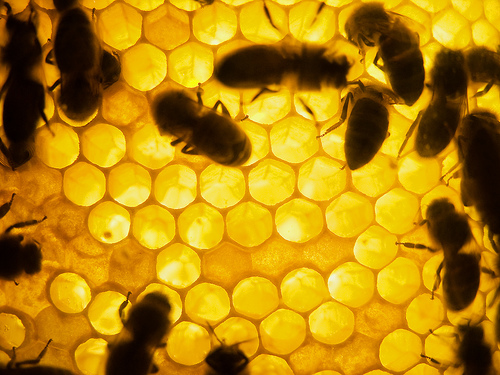 Ask The Plant Expert:
Ask The Plant Expert:
Hi, I have an avocado tree that so far, has not yet produced avocados. I have no idea what kind of avocado tree it is. I have heard that sometime you need another to pollinate, but others say, avocados will grow with only one, but that a second helps you produce more. It is 10ft. tall, in a large, industrial 20″ x 20″ container. I live in Vallejo, California. Thank you, Kimberly
Flower Shop Network Plant Expert Reply:
Kimberly,
As far as I know Avocados are not self-pollinating. In fact, the pollination of avocados is tricky. Besides needing two plants, you need two different kind of plants. On top of that you need to make sure you have a good bee population to more the pollen from one plant to another.
Here are a couple of really good articles on Avocado pollination and culture:
Help! Is My House Plant A Plant Or TREE??
Ask The Plant Expert:
I received this plant a few years ago. It’s now twice as tall as it is in the picture (hitting my ceiling). Can you please tell me what kind of plant/tree it is and if I can get a new start from it? Thanks! -Shannon
Flower Shop Network Plant Expert Reply:
Shannon,
It looks like a type of Dieffenbachia, most likely a Dieffenbachia picta or Dieffenbachia seguine. These types of dieffenbachia can grow to a height of 10ft.
They can be propagated several different ways:
- Root tip cuttings
- Stem cuttings
- Tip cuttings
I recommend stem cutting or tip cutting as your method of propagation. To do this you will need the following:
- Sharp knife
- Rooting hormone (I like the powder kind – you should be able to purchase it at your local garden center and nursery)
- Potting soil (you can simply stick the cutting in your current pot, but I like to place my cutting in a new pot with fresh potting soil.)
To take a tip cutting, go about three or four inches from the tip end and cut the plant right below a joint. Dip the cut end into the rooting hormone and place in the potting soil about an inch deep. Keep the soil moist, but not soggy. Roots should appear in the next couple of weeks. New shoots should also appear on the parent plant where the tip was removed.
As for stems cuttings, you will cut the stems in section 4 to 5 inches long and dip the bottom- end that has been cut in rooting hormone and place in potting soil and care for it the same way as a tip cutting.
Hope this information was helpful. Please let me know if I can help with anything else.
Help! Why Is My Ranunculus Sprout Wilting?
I planted 4 ranunculus bulbs, in a 3 inch plastic pot 10 weeks ago. I had germination signs after 3 weeks; leaves are getting taller, now 4-5 inches tall. Only a couple of days ago they started to wilt, and now they are completely hanging from the sides of the container. I keep the pot in a sunny room, and I water them once weekly from beneath!!!!!!! -Amjad
Flower Shop Network Plant Expert Reply:
 Sounds like you’re doing a good job. Let’s go over the basic ranunculus care and growing information and see if there is a step you may be missing.
Sounds like you’re doing a good job. Let’s go over the basic ranunculus care and growing information and see if there is a step you may be missing.
Your new ranunculus plant should be placed in a sunny location with well-drained soil. This plant likes to live in slightly cooler temperatures. Although they can be planted in containers, the ranunculus produces a large root system.
I would say the problem is either:
- It’s possible your plant has already out-grown it’s container.
- It is too warm.
Try adjusting these and see if it helps! Let us know if you have any more questions.
Can I Grow A New Elephant Foot Plant From It’s Offshoot?
Ask The Plant Expert:
I have an elephant foot plant and I was wondering, can you snip off the leaves growing out the sides of the trunk to grow new plants? Mine is about 4ft. tall. I did slice one off, put it in water, the leaves grew well, but no roots or signs of a trunk developing. Should I just plant it? Thank you for speaking with me, Diane
Flower Shop Network Plant Expert Reply:
The Elephant foot plant (Beaucarnea recurvata, also know as ponytail plant) can be started from an offshoot of the plant. However, a leaf by itself will not form roots. What you need is a true sucker from the plant. These will have a thicker base attached to the trunk of the plant. You can snap these off at the trunk and stick the sucker in soil to root. A rooting hormone, found at any garden center or nursery, can be used to help start your sucker roots. Keep the soil moist but not soggy. If the soil is too wet the sucker will rot and not form roots.
This Flower Was Part Of My Bouquet – What Is It?
Ask The Plant Expert:
This flower was part of a bouquet and dropped a lot of very small round black seeds. What is the name of this plant? – Shirley
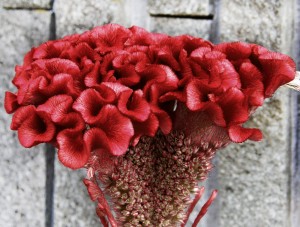
Flower Shop Network Plant Expert Reply: Shirley, the name of flower is Celosia.
This interesting pink flower is commonly called cockscomb because it resembles the comb of a rooster. The genus name is Celosia. The perennial cockscomb is Celosia argentea and the annual types fall under Celosia spicata.
Celosia History
Celosia’s name is derived from the Greek word for “burning.” It grows widespread across Mexico, where it is known as “Velvet flower.” In northern South America, tropical Africa, the West Indies, South, East and Southeast Asia where it is grown as a native or naturalized wildflower, and is cultivated as a nutritious leafy green vegetable. It is traditional fare in the countries of Central and West Africa, and is one of the leading leafy green vegetables in Nigeria, where it is known as ‘soko yokoto’, meaning “make husbands fat and happy”.
Celosia Flower
An interesting addition to the garden, Celosia is also a versatile flower for decorating. Florists use it both as a cut flower in fresh arrangements and as a dried flower in permanent arrangements. So enjoy this wonderful flower while you can – a killing frost will put them to rest for the winter.
How To Propagate An Aquatic Lily From Seeds
My Cahaba lilies have so many seed pods. I would like to use the seeds properly to grow more lilies. Can anyone tell me the best way to go about it? Thank you
Flower Shop Network Plant Expert Reply:
The Cahaba lily (Hymenocallis coronaria) is a little tricky when it comes to propagation. In nature this plant drops it’s seed in the water where the plant is growing. These seeds then wash up on the banks of the river or water way. On the bank, they germinate and grow into new plants. Captive propagation has a very low success rate, but since the seeds are free I would give it a try. I recommend:
- Soak the seeds for 24 to 48 hrs.
- Place them on top of a moist sandy-loam mixture. I would try to emulate the soil on a river bank where the lilies are native. I am assuming this is more mucky than sandy. So try a 1/3 sandy, 1/3 top soil and 1/3 organic matter. (This is a estimation on my part since I have not actually propagated these seeds my self.)
- Keep the seeds very moist until the seeds sprout.
- Once the seeds have sprouted you can transplant them into the area where they will live permanently.
Good luck and please let me know how it turns out. Hope this information was helpful.
Should I Divide Or Plant Seeds For Globe Thistle Propagation?
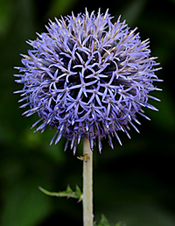 Ask The Plant Expert: I seem to have a mystery plant which I think is a Globe Thistle, but I did not plant it. It is turning into a clump and has tall lavender flowers. Sorry, I don’t have a photo. Can I divide this free stranger or plant seeds from the dried flower head? -Nancy
Ask The Plant Expert: I seem to have a mystery plant which I think is a Globe Thistle, but I did not plant it. It is turning into a clump and has tall lavender flowers. Sorry, I don’t have a photo. Can I divide this free stranger or plant seeds from the dried flower head? -Nancy
Flower Shop Network Plant Expert Reply: From what you describe, propagating by seeds would be your best option. It takes 14 to 21 days for Globe Thistle seed to germinate. You can sow your seeds directly in the ground or in germination cells packs or flats. If you are going to sow directly into your flower beds, make sure the temperatures are at least 65 to 70 degrees. Sow the seeds directly on the ground and do not coil with soil. I recommend planting the seeds in the spring since they normally bloom July through September.
Hope this information was helpful.


 Find Your
Find Your 

